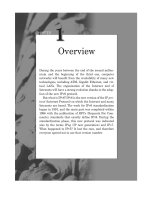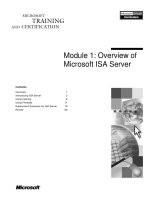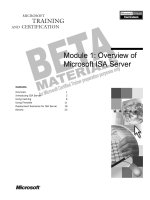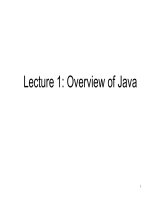Lecture supply chain management chapter 1 overview of supply chain, supply chain management
Bạn đang xem bản rút gọn của tài liệu. Xem và tải ngay bản đầy đủ của tài liệu tại đây (3.26 MB, 18 trang )
06-Sep-21
SUPPLY CHAIN MANAGEMENT
MSC. BÙI THỊ BÍCH LIÊN Course book and support materials
CONTENT • 1. Michael Hugos (2018), Essentials of
Supply Chain Management, John Wiley and
• Chapter 1: Overview of supply chain, supply chain management. Sons Inc. (course book)
• Chapter 2: Supply chain planning
• Chapter 3: Sourcing and procurement
• Chapter 4: Making
• Chapter 5: Delivering
• Chapter 6: Measuring performance of SC
• Chapter 7: Supply chain design and integration
1
References 06-Sep-21
• Tinh hoa quản trị chuỗi cung ứng: Michael Hugos (Essentials Assessment
of Supply Chain Management)
• 50%: In class process
• Quản trị chuỗi cung ứng: Đồn Thị Hồng Vân
• Quản trị chuỗi cung ứng: Những trải nghiệm tuyệt vời – 15%: midterms test (online test – multiple choice)
• Quản trị chuỗi cung ứng hồn hảo: (Peter Bolstorff, Robert – 15%: team work (group presentation) + attendance
Rosenbaum) Nxb Lao động Xã hội • 50%: Final test
• SUPPLY CHAIN MANAGEMENT Strategy, Planning and
– 60- 90 minutes
Operation: Sunil Chopra, Peter Meindl – Multiple choice questions, short questions and practices
• Purchasing Supply Management : P. Fraser Johnson
• Supply Chain Logistics Management: Donald J. Bowersox Learning Objective
• Logistics & Supply Chain Management: creating value-adding Students should be able to:
networks (3rd Edition): Martin Christopher • Appreciate what a supply chain is and what it does
• Understand the structures of supply chains
Chapter 1: Overview of the supply • Define the different organizations that participate in any
chain and supply chain management
supply chain
1 Definition and Objectives (SC, SCM) • Understand the need to align supply chain capabilities
2 Structure and tiering of the SC with competitive priorities
3 How the SC works? 2
4 Participants in the SC
5 Supply chain challenges
06-Sep-21
11 12
3
Why Supply Chain Management? 06-Sep-21
1950-1980s Manufacturing 1. Definition of Supply chain
• 50 years ago, U.S. is the only Parts $5,000 • A supply chain is a network of partners who collectively
country that can manufacture cars. Labor 4000 convert a basic commodity (upstream) into a finished
Overhead 2000 product (downstream) that is valued by end‐customers.
● You buy a car from GM, all the Management (Alan Harrison and et., 2014)
money will go to the GM. Marketing 3000
Total Cost $14,000 • A supply chain is the global network used to deliver
1980-2000s Supply Chain products and services from raw materials to end
Management customers through an engineered flow of information,
physical distribution, and cash” (Blackstone 2013)
• Today, foreign parts and labors are
much cheaper than that in US.
● You buy a car from GM, only a
portion of money will go to the GM.
…………….
…………
…………….
4
1.1. SCM 06-Sep-21
SCM encompasses the planning and controlling of all processes Process Orientation
involved in procurement, conversion, transportation and Coordination, collaboration, synchronization
distribution across a supply chain. SCM includes …co…o…rd…in…at…io.n and Integrating flows
c…o…lla…b…or…at…io.n between partners, which can be suppliers, Throughout from the origin to destination
intermediaries, third party service providers, and customers. In Internal and external
essence, SCM integrates supply and demand management within
and between companies in order to serve the needs of the end‐
customer (Council of SCM Professionals‐CSCMP, 2010)
A picture is better than 1000 words! 1.2 The Objectives of the Supply
How many words would be better than 3 pictures? Chain
- A supply chain consists of 5
Supplier Manufacturer Distributor Retailer Customer
Upstream Downstream
SUPPLY SIDE
- aims to Match Supply and Demand,
profitably for products and services
DEMAND SIDE
achieves + The right + + + + Right = Higher
Profits
Product price Right
Right Right Right Time
Store Quantity Customer
06-Sep-21
Competitive Strategies …Ef…fi…ci…en…c…y R…e…sp…o…ns…iv…en…e…ss.
SC strategies
Structure of SC
Cost Responsiveness
Cost of Making and delivering Capability of the enterprises in Low Total cost High Quality
goods to Customers Variety choice Creation
Meet the right quantity Big volume New and
Production and Location At the right time
Inventory and Transportation Processing and combining purchasing improvement
Information variety of cargoes Little service Unique
Customer service quality Less convenient Speed
1.3 Differences between Logistics and 1.3 Differences between Logistics and SCM
SCM
6
Differences between Logistics and SCM 06-Sep-21
2. Structure and Tiering of SC
Logistics SCM
Management
Activit Transport, warehouse, Logistics + Sourcing +
- ies inventory, order Manufacturing + Coordination
Scope processing, customer + Integration with suppliers
Goal service, forecast, info. and customers … Multi-
Effects management functions
Internal Internal + External
All members of SC
Decreasing Logistics cost,
increasing customer Decreasing system’s cost.
service quality Maximizing the value of the
Short – Term chain
Mid - term
Long – term
Strategies
2.1 Structure of supply chain
7
Complete supply chain 06-Sep-21
Vinmart
8
06-Sep-21
2.2 Participants in The Supply Chain
• Producers
• Distributors
• Retailers
• Customers
• Service providers
3. How Supply chain work A Framework for Structuring Drivers
Sourcing Pricing
Efficiency Responsiveness
Supply chain structure
Facilities Transportation Inventory Information
Drivers
3-36
9
06-Sep-21
Drivers of Supply Chain Performance Facilities
• Facilities • Role in the supply chain
– places where inventory is stored, assembled, or fabricated – the “where” of the supply chain
– production sites and storage sites, distribution centres. – manufacturing or storage (warehouses)
• Inventory • Role in the competitive strategy
– raw materials, WIP, finished goods within a supply chain – economies of scale (efficiency priority): IKEA
– inventory policies – larger number of smaller facilities
• Transportation (responsiveness priority): 7 Eleven
– moving inventory from point to point in a supply chain • Example 3.1: Toyota and Honda
– combinations of transportation modes and routes
• Components of facilities decisions
• Information
Components of Facilities Decisions
– data and analysis regarding inventory, transportation, facilities
throughout the supply chain • Location
– potentially the biggest driver of supply chain performance – centralization (efficiency) vs. decentralization (responsiveness)
– other factors to consider (e.g., proximity to customers, workers, costs
3-37
of facility, availability of infrastructure, macroeconomics…)
Case studies
• Capacity (flexibility versus efficiency: trade-off to determine
• Toyota and Honda use facilities decisions to be more the right amount of capacity to have and used capacity)
…................................. to their customers. These companies
have an end goal of opening manufacturing facilities in every • Manufacturing methodology (product focused versus
major market that they enter. While there are other benefits to process focused)
opening local facilities, such as protection from currency
fluctuation and trade barriers, the increase in …................... • Warehousing methodology (SKU storage, job lot storage,
plays a large role in Toyota and Honda’s decision to place cross-docking)
facilities in their local markets. The flexibility of Honda
facilities to assemble both SUVs and cars in the same plant • Overall trade-off: Responsiveness versus efficiency
allowed the company to keep costs down in the downturn of
2008. While competitors’ SUV production facilities were idle, 3-40
Honda facilities maintained a high level of utilization
10
Inventory 06-Sep-21
• Role in the supply chain Inventory: Role in the Supply Chain
• Role in the competitive strategy
• Components of inventory decisions • Inventory exists because of a mismatch between supply
and demand
Inventory: Role in Competitive
Strategy • Source of cost and influence on responsiveness
• If …................... is a strategic competitive priority, a firm 3-42
can locate larger amounts of inventory closer to
customers Case Nordstrom
• If ….................... is more important, inventory can be • Nordstrom’s competitive strategy targets upper-end customers
reduced to make the firm more efficient with high …...................... requirement. These customers are
willing to pay a premium to have the products they want when
• Trade-off they want them. To support this competitive strategy, company
• Example 3.2 – Nordstrom uses inventory, company stocks a large variety and quantity of
products to ensure a high level of availability. In fact,
3-43 Nordstrom stocks a significantly larger amount of inventory
than other department stores. Nordstrom incurs higher costs
because of its large inventory, but it gain extra margin from its
customers, who are willing to pay for the level of service that
Nordstroms’s inventory makes possible
11
06-Sep-21
Components of Inventory Decisions Transportation
• Cycle inventory: convenience • Role in the supply chain
• Role in the competitive strategy
– Average amount of inventory used to satisfy demand between • Components of transportation decisions
shipments
3-46
– Depends on lot size
Transportation:
• Safety inventory: randomness Role in the Competitive Strategy
– inventory held in case demand exceeds expectations • If …....................... is a strategic competitive priority, then
– costs of carrying too much inventory versus cost of losing sales faster transportation modes can provide greater
…...................... to customers who are willing to pay for it
• Seasonal inventory: unstable demand
• Can also use slower transportation modes for customers
– inventory built up to counter predictable variability in demand whose priority is ….......................
– cost of carrying additional inventory versus cost of flexible
• Can also consider both inventory and transportation to
production find the right balance
• Overall trade-off: Responsiveness versus efficiency 3-48
– more inventory: greater responsiveness but greater cost 12
3-45
– less inventory: lower cost but lower responsiveness
Transportation: Role in
the Supply Chain
• Moves the product between stages in the supply chain
• Impact on responsiveness and efficiency
– Faster transportation allows greater responsiveness but
lower efficiency
• Also affects inventory and facilities
3-47
Case Blue Nile 06-Sep-21
• Blue Nile is an online retailer of diamonds that has used …............... Components of
transportation using Fedex to ship diamonds to customers in the US, Transportation Decisions
Canada, and several countries in Europe and Asia. Given the high
value of diamonds, company offers free shipping for the overnight • Mode of transportation:
delivery. …............. shipping, however, allows Blue Nile to
centralize its inventory of diamonds and also eliminate the need for – air, truck, rail, ship, pipeline, electronic transportation
expensive storefronts. In spite of the high transportation costs, Blue – vary in cost, speed, size of shipment, flexibility
Nile has very low costs compared to bricks – and – mortar retailers
because of the low facility and inventory expense. Blue Nile is thus • Route and network selection
able to offer significantly lower prices than its bricks and mortar
competition – route: path along which a product is shipped
– network: collection of locations and routes
Information
• In-house or outsource
• Role in the supply chain • Overall trade-off: Responsiveness versus efficiency (cost
• Role in the competitive strategy
• Components of information decisions of transportation a product and the speed with which that
product is transported)
3-51
Information: Role in
the Supply Chain
• The connection between the various stages in the supply
chain – allows coordination between stages
– E.g.: Seven Eleven uses information to improve product
availability while decreasing inventories
– Walmart uses information on shipments from suppliers to
facilitate cross-docking and lower inventory and transportation
expense
• Crucial to daily operation of each stage in a supply chain
– e.g., production scheduling, inventory levels
13
06-Sep-21
Information: Characteristics of the Good Information
Role in the Competitive Strategy
Strategy Analytical Models $$$
• Allows supply chain to become more efficient and more
responsive at the same time (reduces the need for a Information
trade-off) Accurate?
Accessible?
• Information technology Up-to-date?
• What information is most valuable?
• Example: Ton Hoa Sen uses ERP, Maersk uses SAP
(Systems Applications and Products in Data Processing)
Components of Information Information: Example
Decisions
• DHL is a logistics and parcel delivery company that operates in
• Push (MRP) versus pull (demand information transmitted more than 140,000 destinations with a presence in more than 220
quickly throughout the supply chain) countries, which involves working in diverse local environments with
different languages, cultures, and local knowledge. For DHL,
• Coordination and information sharing: working locally means that its employees and customers have
access to accurate tracking info. On their packages in their local
– if the supplier is to produce the right parts in a timely manner for a language. DHL moved from a decentralized info system involving 50
manufacturer in a pull system, the manufacturer must share demand systems to a centralized integrated system to reduce risk and
and production info with the supplier decrease costs and,, at the same time, improve customer service.
This resulted in a 40% reduction in infrastructure costs, coupled with
• Forecasting and aggregate planning more reliable communications throughout DHL’s worldwide
• Enabling technologies operation
– EDI: paperless PO, decrease time needed to get product 14
– Internet
– ERP systems: transactional tracking and global visibility of info
– Supply Chain Management software: analytic decision support
• O3-5v5 erall trade-off: Responsiveness versus efficiency
Information – related metrics 06-Sep-21
• Forecast horizon Sourcing
• Frequency of update
• Forecast error • Role in the supply chain: is a set of business processed
• Variance from plan: planned production/inventory >< the required to purchase goods and services. Aim to provide
appropriate level of responsiveness at the lowest cost
actual value
• Ratio of demand variability to order variability.
Sourcing: Example Components of sourcing decisions
• Zara has a souring strategy that varies by product type. • In-house or outsource
For basic product such as T-shirts, Zara aims for • Supplier selection
…................... Because demand is predictable. These • Procurement: direct material and MRO (transaction cost)
products are sourced from suppliers in low cost countries
• For trendy products for which demand is unpredictable,
in contrast, Zara sources from company – owned
factories in Europe. These factories are not …................
But they are flexible and ....................... To the rapidly
evolving needs of the trendy market
15
Pricing 06-Sep-21
• Role in the Supply chain: Affects customer segments to Pricing: Example
buy a product, influencing the customer needs that
supply chain must fulfill • Amazon offers its customers a large menu of prices for products
that are purchased from the company. For example, in January
• Pricing is also a lever that can be used to match supply 2014, a person purchasing 2 books worth $40 could use standard
and demand, especially when the supply chain is not shipping (3 – 5 days) at a cost of $4.98, two day shipping at a
very flexible cost of $14.97, one day shipping at a cost of $24.97, or free
shipping (5 – 8 days). The pricing menu allows Amazon to attract
customers with varying levels of desired responsiveness.
Whereas customers paying for one day shipping impose a high
degree of uncertainty on Amazon, customers opting for free
shipping can be used to level out the work load at the warehouse
over time. Amazon can thus use its pricing to provide
responsiveness to those who value it while using customers who
want a low price to help it improve its efficiency
Components of pricing decisions Considerations for Supply Chain Drivers
• Pricing and Economies of scale
• Everyday low pricing >< high – low pricing
• Fixed price >< menu pricing: website
3-64
16
Case study: Wal-mart 06-Sep-21
17
Lower costs, increase productivity
1. Strategies to expand around distribution centers
2. Using EDI electronic data exchange standard
3. Big box design
4. Every day low price
5. Supply chain challenges
Wrong SCM System and partners’ choice
SCM system is not compatible with
traditional business processes and
activities
Complexity and disturbance within / with
partners
SC Challenges 06-Sep-21
18
Business Environment Product/service
• Globalization • Increase product
• Supply chain
categories
infrastructure • Shorten the life cycle
Supply Chain
Management
Customers Suppliers
• Higher requirement • Pressure to share sales
• More sensitive to the
and risks
price • Potential competitors
”THANK YOU!"









